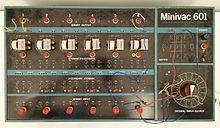
Digital Equipment Corporation, using the trademark Digital, was a major American company in the computer industry from the 1960s to the 1990s. The company was co-founded by Ken Olsen and Harlan Anderson in 1957. Olsen was president until forced to resign in 1992, after the company had gone into precipitous decline.
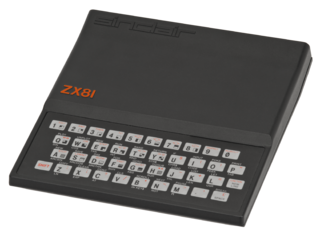
The ZX81 is a home computer that was produced by Sinclair Research and manufactured in Dundee, Scotland, by Timex Corporation. It was launched in the United Kingdom in March 1981 as the successor to Sinclair's ZX80 and designed to be a low-cost introduction to home computing for the general public. It was hugely successful; more than 1.5 million units were sold. In the United States it was initially sold as the ZX-81 under licence by Timex. Timex later produced its own versions of the ZX81: the Timex Sinclair 1000 and Timex Sinclair 1500. Unauthorized ZX81 clones were produced in several countries.

A microcomputer is a small, relatively inexpensive computer having a central processing unit (CPU) made out of a microprocessor. The computer also includes memory and input/output (I/O) circuitry together mounted on a printed circuit board (PCB). Microcomputers became popular in the 1970s and 1980s with the advent of increasingly powerful microprocessors. The predecessors to these computers, mainframes and minicomputers, were comparatively much larger and more expensive. Many microcomputers are also personal computers. An early use of the term "personal computer" in 1962 predates microprocessor-based designs. (See "Personal Computer: Computers at Companies" reference below). A "microcomputer" used as an embedded control system may have no human-readable input and output devices. "Personal computer" may be used generically or may denote an IBM PC compatible machine.
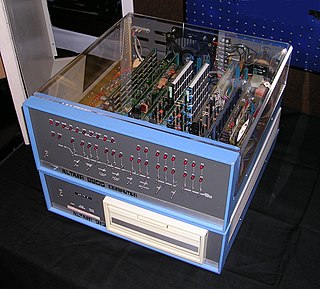
The Altair 8800 is a microcomputer designed in 1974 by MITS and based on the Intel 8080 CPU. Interest grew quickly after it was featured on the cover of the January 1975 issue of Popular Electronics and was sold by mail order through advertisements there, in Radio-Electronics, and in other hobbyist magazines. The Altair is widely recognized as the spark that ignited the microcomputer revolution as the first commercially successful personal computer. The computer bus designed for the Altair was to become a de facto standard in the form of the S-100 bus, and the first programming language for the machine was Microsoft's founding product, Altair BASIC.

Wham-O Inc. is an American toy company based in Carson, California, United States. It is known for creating and marketing many popular toys for nearly 70 years, including the Hula hoop, Frisbee, Slip 'N Slide, Super Ball, Trac-Ball, Silly String, Hacky sack, Wham-O Bird Ornithopter and Boogie Board, many of which have become genericized trademarks.
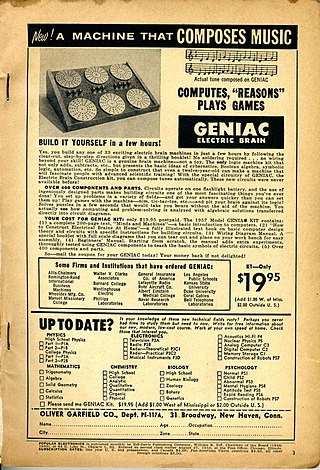
Geniac was an educational toy billed as a "computer" designed and marketed by Edmund Berkeley, with Oliver Garfield from 1955 to 1958, but with Garfield continuing without Berkeley through the 1960s. The name stood for "Genius Almost-automatic Computer" but suggests a portmanteau of genius and ENIAC.
Resistor–transistor logic (RTL) is a class of digital circuits built using resistors as the input network and bipolar junction transistors (BJTs) as switching devices. RTL is the earliest class of transistorized digital logic circuit; it was succeeded by diode–transistor logic (DTL) and transistor–transistor logic (TTL).
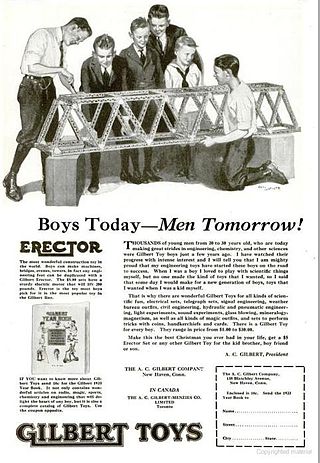
Erector Set was a brand of metal toy construction sets which were originally patented by Alfred Carlton Gilbert and first sold by his company, the Mysto Manufacturing Company of New Haven, Connecticut in 1913. In 1916, the company was reorganized as the A.C. Gilbert Company. The brand continued its independent existence under various corporate ownerships until 2000, when Meccano bought the Erector brand and consolidated its worldwide marketing with its own brand. The coverage here focuses on the historical legacy of the classic Erector Set; for current developments under the "Erector by Meccano" brand name, see the Meccano article.

Heathkit is the brand name of kits and other electronic products produced and marketed by the Heath Company. The products over the decades have included electronic test equipment, high fidelity home audio equipment, television receivers, amateur radio equipment, robots, electronic ignition conversion modules for early model cars with point style ignitions, and the influential Heath H-8, H-89, and H-11 hobbyist computers, which were sold in kit form for assembly by the purchaser.
Micro Instrumentation and Telemetry Systems (MITS) was an American electronics company founded in Albuquerque, New Mexico that began manufacturing electronic calculators in 1971 and personal computers in 1975.
Sinclair Radionics Ltd was a company founded by Sir Clive Sinclair in Cambridge, England and developed hi-fi products, radios, calculators and scientific instruments.

Universal ABIT Co., Ltd was a computer components manufacturer, based in Taiwan, active since the 1980s. Its core product line were motherboards aimed at the overclocker market. Abit experienced serious financial problems in 2005. The brand name "ABIT" and other intangible properties, including patents and trademarks, were acquired by Universal Scientific Industrial Co., Ltd. (USI) in May 2006.

An electronic component is any basic discrete device or physical entity in an electronic system used to affect electrons or their associated fields. Electronic components are mostly industrial products, available in a singular form and are not to be confused with electrical elements, which are conceptual abstractions representing idealized electronic components and elements.
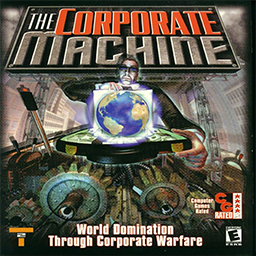
The Corporate Machine is a business simulation computer game from Stardock in which the goal is to create a corporation in one of four industries and eventually dominate rival companies. To win the player must dominate the chosen market. The Corporate Machine is a follow up to the game Business Tycoon, which was itself a sequel to the game Entrepreneur, all developed by Stardock.
CompuAdd Corporation was a manufacturer of personal computers in Austin, Texas. It assembled its product from components manufactured by others. CompuAdd created generic PC clone computers, but unlike most clone makers, it had a large engineering staff. CompuAdd also created a Multimedia PC (MPC), the FunStation, and a Sun workstation clone, the SS-1.

Processor Technology Corporation was a personal computer company founded in April 1975, by Gary Ingram and Bob Marsh in Berkeley, California. Their first product was a 4K byte RAM board that was compatible with the MITS Altair 8800 computer but more reliable than the MITS board. This was followed by a series of memory and I/O boards including a video display module.
Avnet, Inc. is a distributor of electronic components headquartered in Phoenix, Arizona, named after Charles Avnet, who founded the company in 1921. After its start on Manhattan's Radio Row, the company became incorporated in 1955 and began trading on the New York Stock Exchange in 1961. On May 8, 2018, Avnet changed stock markets to Nasdaq, trading under the same ticker AVT.
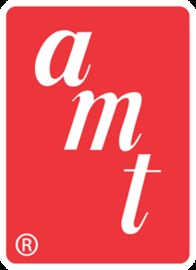
Aluminum Model Toys (AMT) is a toy manufacturing brand founded in Troy, Michigan, in 1948 by West Gallogly Sr. AMT became known for manufacturing 1/25 scale plastic automobile dealer promotional model cars and friction motor models, and pioneered the annual 3-in-1 model kit buildable in stock, custom, or hot-rod versions. The company made a two-way deal in 1966 with Desilu Productions to produce a line of Star Trek models and to produce a 3/4 scale exterior and interior filming set of the Galileo shuttlecraft. It was also known for producing model trucks and movie and TV vehicles.

Educational toys are objects of play, generally designed for children, which are expected to stimulate learning. They are often intended to meet an educational purpose such as helping a child develop a particular skill or teaching a child about a particular subject. They often simplify, miniaturize, or even model activities and objects used by adults.

The history of the personal computer as a mass-market consumer electronic device began with the microcomputer revolution of the 1970s. A personal computer is one intended for interactive individual use, as opposed to a mainframe computer where the end user's requests are filtered through operating staff, or a time-sharing system in which one large processor is shared by many individuals. After the development of the microprocessor, individual personal computers were low enough in cost that they eventually became affordable consumer goods. Early personal computers – generally called microcomputers – were sold often in electronic kit form and in limited numbers, and were of interest mostly to hobbyists and technicians.
